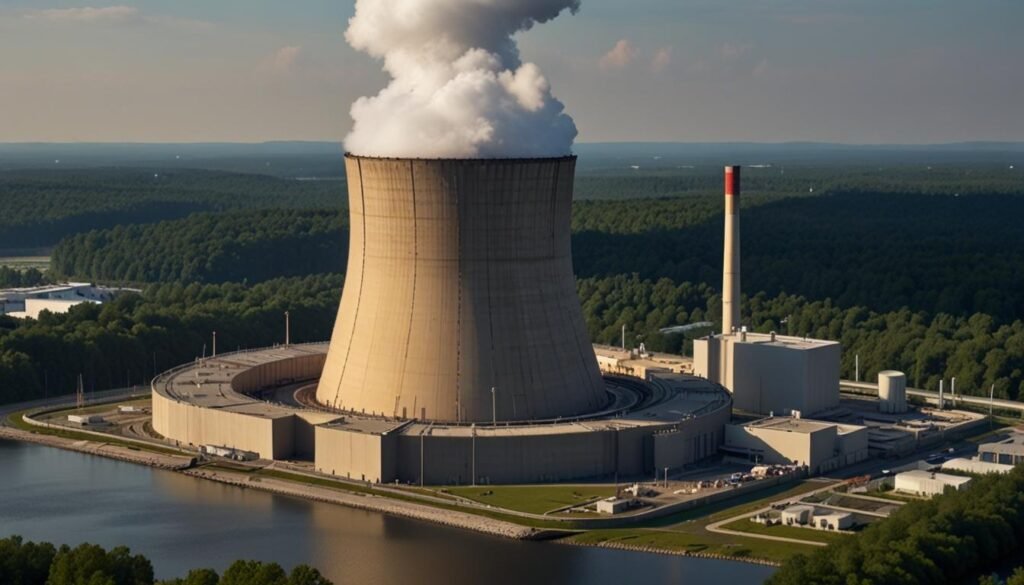Microsoft’s plan to reactivate reactor one at Three Mile Island marks a significant shift as Big Tech seeks low-carbon energy to meet soaring demands from AI and data processing.
Big Tech’s Push for Nuclear Power: The Revival of Three Mile Island
In a significant move, Microsoft has announced plans to reactivate reactor one at the Three Mile Island nuclear power station in Pennsylvania. The reactor, which has been dormant for five years, is set to resume operations in 2028 to provide the tech giant with a substantial supply of low-carbon electricity.
This initiative forms part of a broader trend where major technology companies are increasingly turning to nuclear power to meet the soaring energy demands driven by artificial intelligence (AI) and data processing. Earlier this year, Amazon Web Services inked a deal to purchase power from the Susquehanna nuclear power station in Pennsylvania. Additionally, Alphabet’s CEO Sundar Pichai highlighted the potential of small modular nuclear reactors for powering data centres during an event at Carnegie Mellon University on September 18. OpenAI CEO Sam Altman chairs the boards of nuclear startups Oklo and Helion Energy, underlining the industry’s interest in nuclear solutions.
The rising power demands are rooted in the exponential growth of AI, data-centre operations, and cryptocurrency activities. The International Energy Agency forecasts that electricity demand from these sectors could more than double by 2026. Even conservative estimates equate this increase in demand to the total electricity consumption of a country like Sweden, and in high-demand scenarios, comparable to Germany’s usage.
For the nuclear power industry, this burgeoning demand promises a resurgence. US electricity consumption has plateaued over the past few decades, but the digital transformation era is poised to change this. A report from December 2023 by a power industry consultancy pointed out that the era of flat power demand is ending, predicting peak electricity demand in the US will rise by 38 gigawatts by 2028, which is approximately 46 times the output of reactor one at Three Mile Island.
John Kotek, Senior Vice President for Policy Development and Public Affairs at the Nuclear Energy Institute, highlighted the significant role that AI is playing in reshaping energy consumption patterns. He further noted the national security importance attached to the US maintaining a competitive edge in AI, contingent on adequate power resources. Falling behind in AI advancement due to power shortages could have critical implications.
Nuclear power’s chief appeal lies in its capacity to deliver low-carbon electricity consistently, in contrast to the intermittent supply from solar and wind energy. By reactivating reactor one, Microsoft aims to secure 835 megawatts of low-carbon energy over a 20-year period, aligning with the company’s pledge to be carbon negative by 2030. Microsoft has seen a 29 percent increase in emissions since 2020, driven predominantly by the construction of new data centres, making the quest for sustainable energy solutions ever more urgent.
Historically, the Three Mile Island station is most infamous for the partial meltdown of its second reactor in 1979. This incident left reactor two permanently out of commission, while reactor one continued operations without incident until it was shut down in 2019 due to financial constraints, primarily competition from cheaper gas and wind energy sources. John Kotek notes the scarcity of idle reactors that could be readily reactivated, yet there’s significant interest among power plant owners in extending the operational life of existing plants to capitalise on this new wave of energy demand.
With government incentives such as the Inflation Reduction Act offering tax credits for electricity production at nuclear power plants, there is a push to keep existing low-carbon power sources online and to potentially build new reactors to meet projected demands. However, the US has struggled with timely and budget-effective construction of nuclear facilities, as evidenced by the Vogtle power plant in Georgia, which took over 14 years to build at more than twice the estimated cost. In contrast, countries like China have demonstrated quicker construction times for nuclear plants.
Given these challenges, Microsoft is exploring small modular reactors, deemed quicker and less costly to build, as a more feasible route. Concurrently, there’s a call within the industry to improve AI operation efficiency to curb escalating power consumption. Sasha Luccioni, AI and Climate Leader at Hugging Face, suggests regulation could incentivise better efficiency, starting with mandatory reporting and transparency for AI service providers. Pichai acknowledged the nascent phase of efforts to enhance AI energy efficiency, indicating potential improvements in how AI models are trained and operated.
Google faces similar pressures, with a 48 percent rise in emissions from 2019 to 2023 due to increased energy use in its data centres and supply chain emissions, jeopardising its goal of net-zero emissions by 2030. The surging energy demands of AI thus present a critical obstacle, with renewable or low-carbon energy sources struggling to keep pace.
Despite the historical baggage of Three Mile Island, experts like Todd Allen, Chair of Nuclear Engineering and Radiological Sciences at the University of Michigan, assure that the focus will be on ensuring reactor one’s operational safety and adequacy of trained personnel for its smooth running.
The intersection of AI advancements and nuclear power revival marks a pivotal chapter in the energy landscape, driven by the imperative for sustainable and reliable energy to support the future’s digital infrastructure.
Source: Noah Wire Services


